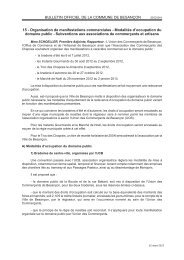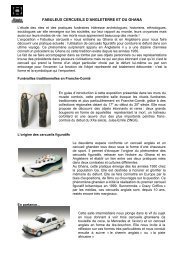An inventory of works within the city walls - Besançon
An inventory of works within the city walls - Besançon
An inventory of works within the city walls - Besançon
Create successful ePaper yourself
Turn your PDF publications into a flip-book with our unique Google optimized e-Paper software.
18<br />
18<br />
Bregille bastioned tower<br />
Seventeenth and nineteenth centuries<br />
Avenue Arthur Gaulard<br />
Built between 1687 and 1689,<br />
it is <strong>the</strong> only bastioned tower to be<br />
built entirely <strong>of</strong> stone and had an<br />
annular vault on a central pillar,<br />
containing a well. It had to provide<br />
flanking for <strong>the</strong> Rivotte tower<br />
and also had a defensive role for<br />
<strong>the</strong> Saint-Paul mill. At <strong>the</strong> end <strong>of</strong><br />
<strong>the</strong> nineteenth century, it was converted<br />
to a military dovecote, which would<br />
continue to be used until 1920.<br />
19<br />
19<br />
Rivotte bastioned tower<br />
Seventeenth and nineteenth centuries<br />
Avenue Arthur Gaulard<br />
The Rivotte bastioned tower was built<br />
between 1687 and 1690. Its foundations<br />
were built on <strong>the</strong> rock, on <strong>the</strong> bank <strong>of</strong><br />
<strong>the</strong> river and <strong>the</strong> ditch situated in front<br />
between <strong>the</strong> Doubs and <strong>the</strong> citadel hill,<br />
was filled with water. The rampart was<br />
modified when <strong>the</strong> <strong>Besançon</strong> - Le Locle<br />
railway line was built at <strong>the</strong> end <strong>of</strong> <strong>the</strong><br />
nineteenth century, <strong>the</strong>n again, when <strong>the</strong><br />
river port was modified in 1938.<br />
Like <strong>the</strong> Bregille bastioned tower,<br />
it has a circular vault on a central pillar<br />
containing a well. This well formed a<br />
link with <strong>the</strong> upper-floor platform,<br />
for <strong>the</strong> passage <strong>of</strong> personnel and<br />
equipment. In <strong>the</strong> nineteenth century,<br />
when <strong>the</strong> ro<strong>of</strong> was built, this well was<br />
opened up in order to collect rainwater.<br />
20<br />
20<br />
Porte Rivotte gate<br />
Middle Ages<br />
Rue Rivotte<br />
Created in <strong>the</strong> Middle Ages in <strong>the</strong><br />
wall built along <strong>the</strong> river, <strong>the</strong> Porte<br />
Rivotte gate guarded <strong>the</strong> passage<br />
between <strong>the</strong> Doubs and <strong>the</strong> citadel<br />
rock to protect <strong>the</strong> town. In <strong>the</strong> first<br />
half <strong>of</strong> <strong>the</strong> sixteenth century, on <strong>the</strong><br />
initiative <strong>of</strong> Emperor Charles V,<br />
<strong>the</strong> municipal authorities streng<strong>the</strong>ned<br />
<strong>the</strong> fortifications <strong>of</strong> <strong>the</strong> loop. The Porte<br />
Rivotte gate was <strong>the</strong>n widened and<br />
a drawbridge installed between <strong>the</strong><br />
two conical-ro<strong>of</strong>ed towers. After<br />
<strong>the</strong> French conquest, its central part<br />
was reconstructed. The façade is still<br />
decorated with <strong>the</strong> royal sun, emblem<br />
<strong>of</strong> Louis XIV. A new modification,<br />
in 1893, entailed removal <strong>of</strong> <strong>the</strong><br />
drawbridge and <strong>the</strong> portcullis, filling<br />
in <strong>of</strong> <strong>the</strong> ditches on <strong>the</strong> town side,<br />
destruction <strong>of</strong> <strong>the</strong> building <strong>of</strong> <strong>the</strong><br />
town and building <strong>of</strong> walkways<br />
through <strong>the</strong> towers. With <strong>the</strong> porte<br />
Taillée*, fur<strong>the</strong>r up <strong>the</strong> route de la<br />
Suisse, <strong>the</strong> Porte Rivotte gate is <strong>the</strong><br />
last <strong>of</strong> <strong>the</strong> town’s fortified entrances.<br />
* Originally, Mont Saint-Étienne, on which <strong>the</strong> citadel<br />
was built went straight down to <strong>the</strong> river. It was not<br />
until <strong>the</strong> ninth and tenth centuries that an access<br />
road was built towards <strong>the</strong> district with a fortified<br />
gate, <strong>the</strong> porte Taillée. The latter was widened in<br />
<strong>the</strong> tenth century to enable access <strong>of</strong> pedestrians,<br />
cavalry and carriages <strong>the</strong>n was modified several<br />
times over <strong>the</strong> course <strong>of</strong> <strong>the</strong> centuries. It was<br />
a first line <strong>of</strong> defence, <strong>the</strong> real gate being <strong>the</strong><br />
Porte Rivotte gate, an opening in <strong>the</strong> wall <strong>of</strong> <strong>the</strong><br />
fortifications surrounding <strong>the</strong> loop in <strong>the</strong> river Doubs.

















